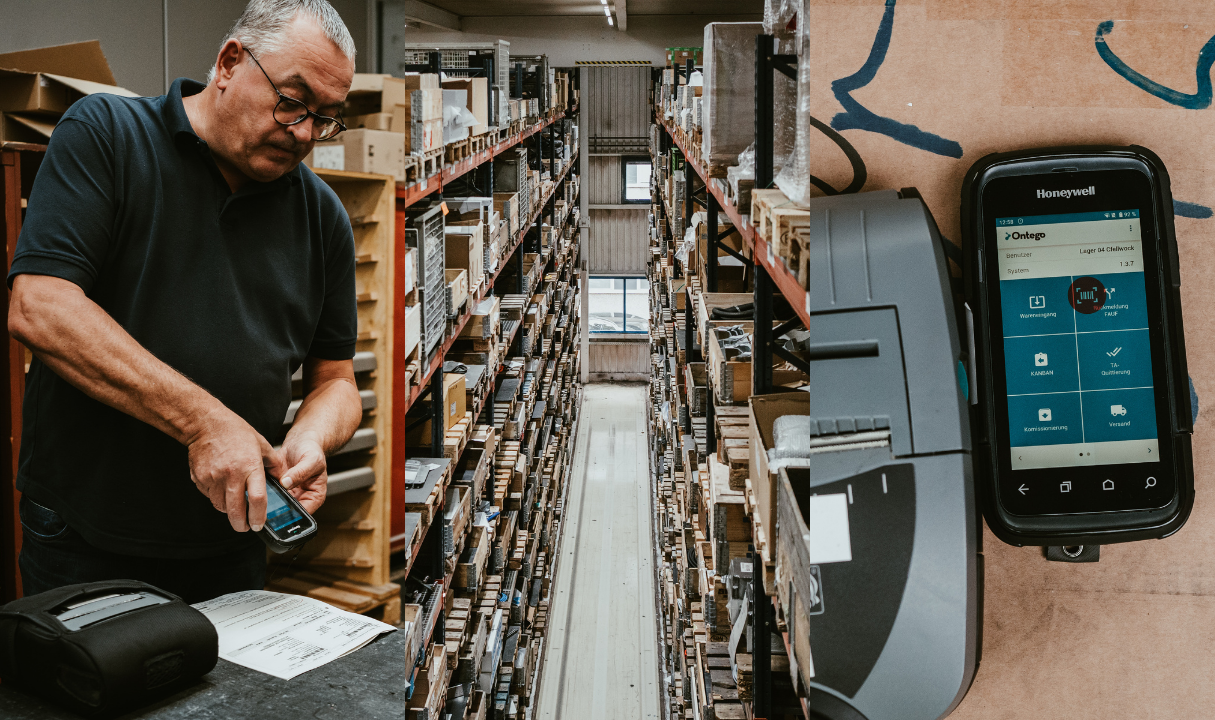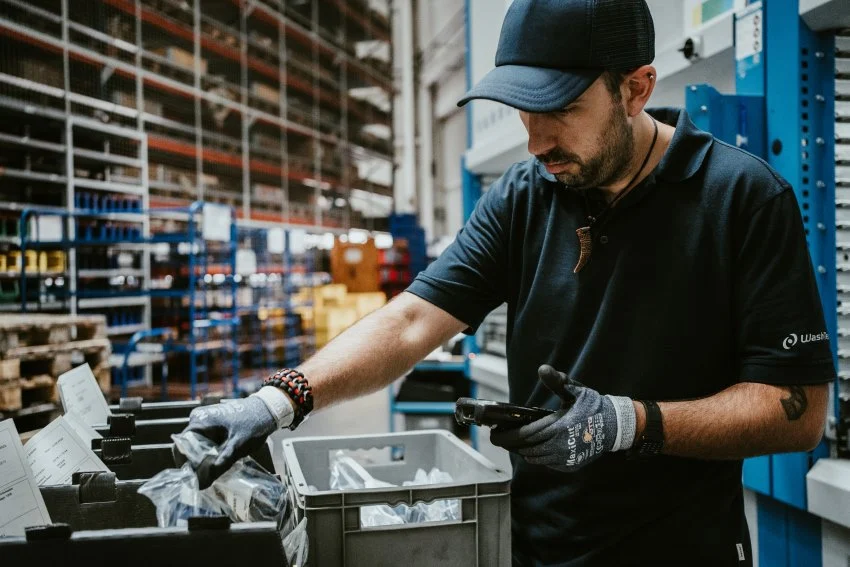Topics
WashTec – a name synonymous with expertise in automated vehicle washing. The company focuses on make-to-order production as well as complex shipping procedures—both of which are supported and documented by a mobile solution for its SAP-managed logistics processes.
The global market leader for vehicle washing systems—including gantry car washes, conveyor tunnel systems, and self-service and commercial vehicle washing systems—relies on an SAP ERP system to manage its business processes. The Augsburg-based group uses SAP to organize all relevant procedures related to its:
- Production and logistics in Augsburg, Grebenau, Recklinghausen, as well as its international locations
- 40,000 car wash systems (washing more than 2 million vehicles daily)
- Over 1,700 employees in more than 80 countries
- 600 of its own technicians in Europe and 300 technicians at sales partners
- Service offerings such as regular maintenance, chemical supply, bay cleaning, and visual overhauls
Being More Efficient and Saving Time
The path to market leadership isn't just paved with competitive products. Optimal processes in manufacturing and logistics also contribute to a company's success. One of the people responsible for these processes is Stanislas Fourrier. "I am responsible for the plant in Augsburg," says the Head of Logistics International, "and I also have professional responsibility for our colleagues in the Czech Republic and support logistics projects, including those at the plants in the USA and China."
The logistics department at the main site in Augsburg covers the entire goods receipt process, warehouse management, material supply to the production areas, and the shipping of pre-assembled washing systems. At WashTec, they live by a culture of continuous optimization. A key component of these efforts was the introduction of a solution for mobile data entry with SAP back in 2013.
"The motivation at the time was to prevent employees from having to walk back to their workstations every five minutes to confirm transfer orders or set Kanban containers to empty, and instead to allow them to perform these tasks right where the action is happening," recalls Fourrier. The transition to paperless work was carried out step-by-step. First, the mobile confirmation of TOs was implemented, followed later by mobile booking of goods receipts, mobile picking, and handling unit management on the handhelds. And so on—all the way to integrating storage lifts into the mobile solution.
Be efficient by syncing your warehouse and production
Order-Based Production Using a Network Plan
"The cycles for assembly and shipping are oriented around the desired delivery date for each order," explains Fourrier. Once the desired date is commercially verified by the sales team and technically verified by the order center, it is fixed in the network plan—and from that point on, the plan sets the pace. Production and shipping planning are then aligned with this date. All work steps, from sheet metal fabrication and painting to assembly and shipping, are then typically completed within four weeks.
Efficient Material Flow with SAP and MDE
To meet these deadlines, a smooth material flow into production is essential, along with detailed and accurate documentation in SAP. To achieve this, WashTec uses a mobile Ontego app that is customized to its specific SAP setup. The MDE solution is used in Augsburg, in smaller production facilities like the AUWA chemical plant in Grebenau and the electronics plant in Recklinghausen, as well as in Denver (USA) and Pilsen (Czech Republic).
The motivation at the time was to prevent employees from having to walk back to their workstations every 5 minutes to confirm transfer orders or set Kanban containers to empty.
— Stanislas Fourrier, Head of International Logistics, WASHTEC Group
What began as a simple way to book transfer orders for production supply has evolved into a sophisticated scanner solution. Today, employees in goods receipt, picking, production logistics, as well as shipping and inventory counting all work on mobile devices, says Fourrier. A few specific integrations and functions in WashTec's mobile solution particularly stand out.
Two-Step Picking
While the initial motive for introducing the mobile solution was to confirm transfer orders more efficiently, the solution was later adapted for two-step picking, reports Fourrier. The expansion included material staging for production orders, and here, too, the push for greater efficiency was the key driver.

Fourrier outlines an example: Instead of processing one transfer order after another, sequentially and in isolation, an employee today scans multiple open TOs from SAP at once and then picks the total required quantity for all those orders in a single physical step. This total quantity is then taken to a consolidation area where it is allocated to the individual orders, and the TOs are booked in SAP.
"A lot of efficiency was gained through this," Fourrier says happily. Between 2020 and 2022, they were able to achieve a time saving of several percent each year in processing transfer orders compared to the system-calculated order duration. Fourrier concludes: "The average processing time used to be 5 minutes per transfer order. Thanks to the continuous time reduction per order, an employee can now process significantly more TOs in the same amount of time."
Kanban with RFID
For its production supply, WashTec relies on a Kanban system, among other methods. Today, the company uses an RFID-based system. "We receive a cart with empty, anonymous containers," describes Fourrier. "As soon as a container is empty, a production employee drops an RFID tag into our collection box. This automatically generates a transfer requirement and, subsequently, a transfer order." This transfer order can then be used to initiate a removal from the storage lift—more on that in the next section.
Once the employee has picked the requested material and refilled the container, the mobile device sends a print job to an RFID printer. This printer creates an RFID label with the Kanban ID and other data, which is then used to identify the previously anonymous container and its contents.
Mobile Integration of the Storage Lift
Automated warehouse systems are becoming more and more common in logistics. At WashTec, automated systems from the Swiss manufacturer Kardex support small parts management. WashTec achieves a noticeable efficiency gain through the direct integration of the automated retrieval process into the mobile solution. Specifically, this means the Ontego app communicates with the storage lift via a web service interface.
.webp)
Previously, an employee would enter the desired tray number on the shuttle's monitor and then wait for it to be automatically provided. This waiting time was significantly reduced by integrating the shuttle with the scanner solution.
The concept was designed so that while an employee is picking items, the logistics app at the storage lift is already requesting the tray for the next TO item. This way, the employee can directly retrieve the required materials and process transfer orders much more quickly.
Without wanting to give specific figures, Fourrier estimates the time savings per item to be clearly measurable. With several thousand transfer orders per week, the time savings add up to a considerable amount.
Loading Check and Photo Documentation
Large-format deliveries, distributed across multiple trucks and assembled by external teams, also require very specific mobile processes in shipping. Handling Units (HUs) are the foundation for these mobile loading processes. The loading check is ensured simply by scanning the HU number. This allows for easy allocation to the respective delivery and transparently documents that the shipment is complete.
.webp)
Fourrier emphasizes that integrating photo documentation into the mobile solution has been a major benefit. Since assembly is mostly done by subcontractors, there were recurring situations in the past where subcontractors would report missing parts. Today, photo documentation is a standard part of the loading process. Shipping employees take photos of the truck, the washing gantry, the accessory packs, and the rails—and these photos are linked to the delivery.
"That has helped enormously," assesses the logistics manager. Thanks to the accurate documentation, subcontractors are now held more accountable to carefully check and document the load upon delivery, preventing them from hastily re-requesting material.
Mobile Inventory Counting
A classic topic, but also an application with great added value, is digital, direct inventory counting. Previously, they had worked with offline scanners that essentially just captured the material number and quantity. Now, with the synchronized Ontego app, a real-time check can be performed by the SAP system to identify potential entry errors. "The app might say, for example, 'this material is not associated with the production supply area,'" Fourrier illustrates. The live synchronization with the SAP system that is now possible has eliminated these issues. "Inventories take less time. We've become faster with the mobile solution."
.webp)
Conclusion
As the global market leader in its segment, WashTec has relied on mobile SAP processes in warehouse logistics, production, and shipping for 10 years. The Augsburg-based company's logistics app is defined by flexible processes and the integration of third-party systems like storage lifts and RFID printers. The overarching goal, both for the initial introduction and its ongoing development, is the pursuit of efficiency. The measurable results of working mobile include saving time on repetitive tasks and avoiding unnecessary costs, such as those from the preventable re-shipment of parts for final assembly.

Optimize your warehuose easily and budget-friendly with the Ontego subscription model.

